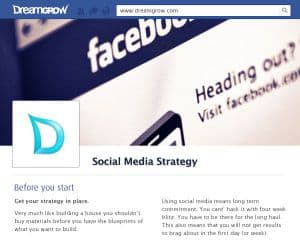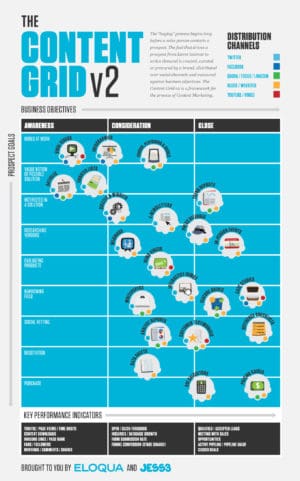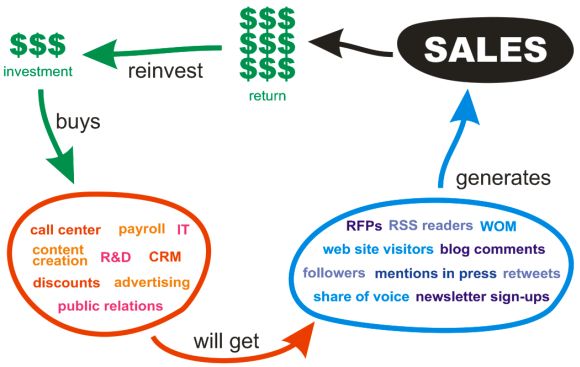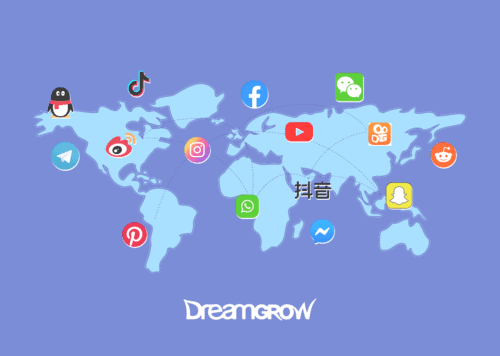Create an actionable social media strategy before you start posting stuff.
I will give you easy to follow steps that help you give your social media strategy a solid foundation.
What is a social media strategy?
The strategy is the why and what part of your social media activity. The term social media strategy seems abstract, and that is why people often go directly to tactics.
Tactics feel more like real work.
Curb your itch to go for the new shiny tools and create a plan first. Very much like building a house you shouldn't buy materials before you have the blueprints of what you want to build.

First get your mindset straight. Using social media means a long-term commitment.
You can't hack it with four-week blitz. You have to be there for the long haul. Long-term also means that you will not get results to brag about on the first day (or week).
Small businesses with thorough social media strategies can compete with much larger organizations.”
— John Jantsch, Duct Tape Marketing
The following step by step overview will help you how to develop a social media strategy and get measurable results.
A list of items that you need to do and why you want to do it. How to measure results and determine ROI. You should have a clear understanding what resources you have at your disposal. If you get all this done, execution should be a breeze!
1. What Do You Do?
Describe what your company does in a single sentence. Make it Twitter short – max 140 characters.
Make it simple; this should be clear to a five-year-old. Measure conversations and your marketing messages against that to maintain focus.
2. Listen to the Conversations
Now that you know what you are doing find out who's talking about it. Find all the conversations that mention your brand or relate to you in general.
- who is talking about your brand
- what they are the talking about (positive or negative)
- what content gets the most reactions
- what channels are used
- what are the most important social media channels for your brand
- what is the volume of conversations
- who are the influencers in each channel
- now repeat that for your major competitors

Start with the free tools and you will see if you need to spend money on paid ones. Remember 90% of analysis is your brain power and 10% is tools.
For example, find out how many mentions of your field are there on the social media channels and how many are about your brand. One of your goals might be to increase that ratio (share of voice).
3. Set a Goal for Your Social Media Strategy

In the end, you have to produce results, and this is where you should write it down.
There are a lot of different goals. What has to happen so you would say it's working?
Select the one that makes the most sense in your business:
- Sales
- Brand awareness
- Brand reputation
- Share of voice
- Customer loyalty
- Lower support cost
- Reduce R&D spend
In the beginning select just one of these and build your social media strategy to achieve that. After you have made some progress with your initial goal and have real measurable results that reflect on your bottom line then you can select another goal from the list.
What gets measured gets done! Put a number on your goal.
This number should be as easy to measure as possible. For instance, brand awareness is not easy to measure. It is hard to attribute the increase in awareness to just social media if you are using other channels as well.
Sales and lowering the support cost should be the easiest goals to measure. These are the goals that have a most direct impact on the bottom line. In turn, that should get your support from top management.
Take a look at the social media KPIs to use in your planning process.
4. Find Influencers and Communities

Who has a following that might include your clients or prospects? Are there advocates who are really into your brand?
Select the ones that you feel are the best match for your business and start monitoring them. Having a conversation with your influencers is a big part of the social media strategy.
Set up a Google Alert for your brand names and industry terms. Scan the Facebook and Twitter to find who are actively talking about your brand and industry. Find out if there are any smaller social networks specialize in related topics.
Also, start tracking social bookmarking and news sites like Digg and StumbleUpon.
Measuring influence seems easy, but all the information might not be available. The numbers that are usually easier to get to:
- Number of comments should give pretty good understanding how engaged the readers are. Comments per post is a good indicator.
- Blogs usually show the number of RSS subscribers, use it as a gauge to measure influence.
- Similar metrics to RSS subscribers are friends an followers on social networking sites.
- Alexa traffic rank and other statistics are a rough measure of a sites importance. It will also give you general audience demographics.
- Find out from your analytics how much traffic do they send to your site.
- Check the footprint: size of the site (enter site:yourtarget.com into Google search) and how long has the domain been around.
- Inbound links are a good predictor of a sites importance but you have to check if the links are from topically related sites otherwise it might just be spam.
- Mentions in other sites: Twitter, social bookmarking and news sites.
5. Who is Your Audience?

When shaping your social media strategy, identifying your target audience is a fundamental step.
Think about who will be most receptive to your message? Who can gain the most value from your offerings? Who is most likely to engage on popular social media channels?
It's a balancing act between specificity and reach. Over-diversification of your message could result in mediocre results. Thus, having a well-defined audience is key.
Once you’ve identified your target audience, you should start digging deeper to understand their behavior on social media. What platforms are they using? What are they doing there?
Keep in mind the 1-9-90 rule as you evaluate your audience:
- Only about 1% of people participate actively.
- 9% comment and interact occasionally.
- 90% are lurkers who do not contribute anything to the conversations.
To illustrate this, consider MarketBeat, a leading stock market news and research tools website. MarketBeat has likely identified its target audience as older, financially sophisticated individuals.
These are individuals who actively seek reliable financial news, stock market trends, and advanced research tools to make informed decisions about their investments. This audience isn’t likely to be most active on platforms like TikTok or Snapchat, which typically cater to a younger, more casual user base. Instead, you'll find them on platforms like Twitter, which is excellent for real-time updates on market trends and financial news. Or LinkedIn, where professional and industry discussions are more prevalent.
Let's look at other examples:
A fitness brand like Equinox, targeting younger, health-conscious individuals, might find their audience more active on Instagram, given the platform's visual nature and popularity among younger demographics.
On the other hand, a B2B software company like Zendesk will likely encounter its audience on LinkedIn, where professional conversations, networking, and knowledge-sharing occur.
6. Do They Know You?
What do they know about you? Have you ever interacted with your target? The following list is in order of importance, and you should choose one from the list:
- Fans/Brand advocates
- Loyal, repeat actions
- They have interacted with you
- They know your name
- Never heard of you
I suggest that you start with the Fan/Brand advocates. These are the people who are easiest to engage.
You can recruit them to spread the word and bring others over to their way of thinking.
If you are just starting out then, this might be a small group, but it's more important who you are talking to than how many.
Starting your social media strategy from people who already know you helps you spread the word
7. Turn What You Do into a Simple Message
This message should make the Fans happy.
This is most likely the reason why people buy from you, and this will be the cornerstone of your social media strategy.
One way to find out would be to go to your fans and ask why are you buying from you?
Hopefully, this is a match with your vision. It's more than just the unique selling proposition or a pragmatic reason to buy.
It should move your target audience emotionally, be meaningful for them.
8. Plan the Content for Your Social Media Strategy

Make a schedule, how often are you going to create content.
For example, you can decide to write three blog posts per week, make one video and update your status every working day on selected social networks.
Make sure you have the time for those activities. Don't forget that you are trying to start conversations so plan some time for answering comments and feedback.
Creating content takes time, so, get help from others from your organization. You may need to think about creating a content marketing strategy.
After you have made a schedule for content delivery start pumping out ideas to talk about.
Brainstorm within your company or with friends. Ask your audience what they want to know. Check if any comments need a longer reply. Generate a long list (25+) of headlines for your content.
What to write about? “I have nothing to write about” is the number one excuse for not getting started. So, here are some of the topics you could cover:
- industry trends
- top 10
- advice about x
- news
- interview with a specialist
- industry events
- ask questions
- review products
- find a guest blogger
- pros and cons of x
- important people in the industry
- helpful books
- really long list of industry resources
- answer comments
- series of posts
- list of best posts
- explain the complicated
- a picture
- x for beginners
- industry statistics
- survey the audience
- how-to
- list of web based tools
- legislation
- myth buster
- rewrite old posts
- case studies and best customers
- issues in your industry that need attention

Just relax and act normally. Put some passion into it. Get excited but don't hype.
For search engine visibility you need keyword research.
Ask yourself, what are the search queries that your site has to have an answer for. Use keywords in your articles.
In some cases, keyword or phrase may trigger an article idea. Make sure you think about SEO when creating your social media strategy.
But content is not just text or video. You can create web-based tools that make your audience's life easier. For example, a loan calculator is a must-have tool for financial institutions, such as UnitedFinances has done.
When you create a useful tool, it can become a leading industry resource, bringing in traffic and links. Check out the content grid.
Examples of tools include:
- Search engine rank checkers
- Price estimators
- Shipment tracking
- Online quizzes
- Calorie calculators
- Expense tracking tools
- To-Do lists
- Games
It doesn't have to be that simple, one example from GE: Heavy Duty Gas Turbine-Generator Configurator (configure gas turbine-generator sets and request a budgetary quote for the heavy duty gas turbine).
What kind of static content do you put on your pages?:
- About us,
- people,
- products and services,
- terms and conditions,
- warranty information,
- manuals, support,
- frequently asked questions.
For most companies this is the only content on the web site. My suggestion is to rewrite the material so that all features are presented as benefits and value for client.
Don't make them think.
What kind of consumer-generated content are you going to use on your site? Do you include customer feedback on products and services, rating systems, recommendations, reviews? In what form, on which parts of the site, are you going to moderate user contributions, how?
90% of consumers online trust recommendations from people they know; 70% trust opinions of unknown users. (Econsultancy)
Most important: Concentrate on the need of your audience, keep yourself in the background.
9. Channels, Tools, and Distribution

The result of this step is a list of tools and channels you start using in your social media strategy.
You know what channels your audience uses – go there. You know what type of content makes your audience act – create and distribute.
Nobody is going to hang around your site. There may be a few people who visit regularly but don't sit and wait. Go where the people are.
Articles and press releases. Optimize for search. Add links to videos and relevant material on your site and distribute to selected channels. There is a huge difference in traffic between just waiting for them to come and actively seeking out your audience and bringing content to them.
News feeds. Make all your content available via RSS feeds. Posts, comments, web pages… everything.
Enable sharing let others do the distribution. Share buttons to add your content to social bookmarking and news sites. (Twitter, Reddit, StumbleUpon, Facebook, etc.).
Don't overdo it. You know what channels are important for your audience, use these. Check your stats and remove the sites that do not generate traffic.
Industry blogs. Don't spam. Participate in conversations and when appropriate add links to your content. Establish a meaningful relationship with the bloggers, and it will really work for you.
Images, video, podcasts. Use the appropriate services to host the materials but always post the material on your site too. Even if the location of the video or image is somewhere else, your website should have an article that points to that content.
Widgets and tools. Put them on your site and let people know. In the selected channels find where people are looking for solutions that your tools can provide. Join the conversations and share the value.
Social networks and news sites. In general, all information you release should reflect on your social media profiles. Status updates on Facebook, Twitter, and other networks are the hooks that bring people to your content and give them the opportunity to share it with their friends.
If you add content more than once a day, then you should experiment with the frequency of updates so that followers wouldn't perceive you as spammy.
Don't forget to distribute your content to news sites. StumbleUpon and Digg are probably most important of those, but your niche might have other special news sites.
Color me old-fashioned, but ownership of content is important. Your website is your marketing foundation, and everything you create should also find a place on your website. Link your site to social networks and give people an easy way to share your content.
I do not recommend automatically linking all the social media channels so that Twitter and blog post to Facebook and Facebook updates go to Twitter.
Automatic linking makes it easy to lose track of what’s posted and where should you participate in conversations.
10. Conversations
In a study conducted by social networking site myYearbook, 81 percent of respondents said they'd received advice from friends and followers relating to a product purchase through a social site; 74 percent of those who received such advice found it to be influential in their decision. (Click Z)

Engage, interact.
You want to open two-way communication and form communities around your brand. The content you are creating should make it easy to start and maintain conversations.
Participate in conversations about your field of activity. Ask questions and provide answers. On your own site and social media accounts keep the conversation going by replying and commenting.
To boost the conversations be personal and identifiable.
Social media is for people, and people don't want to talk to faceless brands.
Don't participate just as “support person” or “sales representative,“ John and Mary work a lot better.
Be transparent! Don't use fake names. Spread openness throughout the organization, let more people talk to the world. Smaller companies have an advantage here as they are more personal to begin with.
Our survey showed that in smaller organizations the social media leadership comes from the CEO and in larger businesses, marketing department leads it.
Put the social media activities on your calendar and decide how much time are you going to spend listening, posting and replying. If you don't know how long it will take, make a guess, and you can adjust the estimates later. Answer quickly, set a standard how fast to answer an update in a conversation.
You can exceed the time you have allocated but always make note how much time you spend on social media, this is part of your ROI calculation.
Do not censor criticism! Answer all critical comments openly and honestly. Friendly voice. Neutral position. We understand you, and we want to help you with that.
Concentrate on the problem, not people or communications. Being open about negative aspects of the social media builds trust and makes you more believable.
A study by KellerFay group found nearly two-thirds (62 percent) of brand-related talk features products in a positive light, while less than one in 10 conversations feature products negatively.
Open negative feedback establishes authenticity. Act on negative feedback and make your organization better. Show off the improvements initiated by criticism on social media.
11. Results and Social Media ROI
How do you know your social media strategy is working? What does success look like? In the end, ROI is about the money. Do you get more value out of the social media activities than you put in?
In step 3 I suggested that you set a highly measurable goal such as sales or support cost reduction.
ROI = (return – investment) / investment.
If you did that, it's pretty straightforward to calculate if you are in the black. If you have a more complicated sales process, then you need to set some key performance indicators that represent visitor's non-financial activities.
- Website visitors
- Conversion rate
- Leads
- Brand awareness
- Newsletter sign-ups
- Facebook fans
- Blog comments
- Social mentions
- Visitor satisfaction index
Now, you need to figure out the connections between these results and dollars earned. Start with the simplest of correlations. Here are just a few examples:
How is the number of your monthly website visitors related to revenue? Segment that and tie website visits to revenue from online and offline segments. Segment yet again and find the most effective online revenue drivers.
What you want to know is if site traffic increases X% then revenue goes up how much?
Find out if the customers who are your Facebook fans make purchases more often.
Check if the Facebook fans are making larger transactions than average. What you want to know is if your Facebook’s fan-base grows X% then what’s the corresponding increase in the frequency of transactions.
Start monitoring the social chatter and tie the number of mentions to changes in sales volume. Segment that and find out what channels have the most impact on the bottom line. On the other hand, you have to keep track of all your spending.
Social media expenditures can be any of the following:
- Your time
- Advertising
- Content creation
- IT
- Public relations
- Discounts
- Call center
- Payroll
- R&D

Be consistent drop money-losing instruments and persist.
Social media is a long-term activity. Six months is just getting your feet wet.
A year is a long enough period to start seeing real results. Don't be afraid of not achieving your goals immediately. Review, adjust and improve.
The greater danger for most of us lies not in setting our aim too high and falling short, but in setting our aim too low, and achieving our mark. ~Michelangelo Buonarroti
12. Start Doing It!
Your social media strategy is great, but you need to get out there and start executing. Every day. Find out how to budget social media time in your schedule.
If you have anything to add, please do that in the comments.
_________________
Image credits: Miguel Ugalde, Sachin Ghodke, Ilker, Frank Hermers, Peter Suneson, Rob Owen-Wahl, Jean Scheijen, Flavio Takemoto




